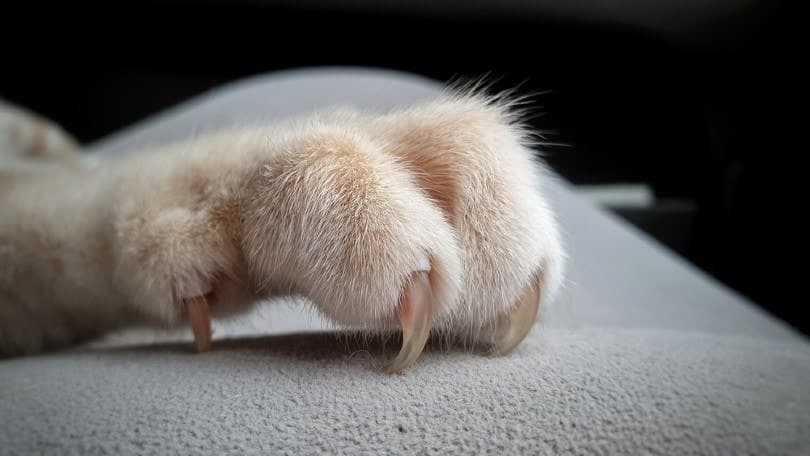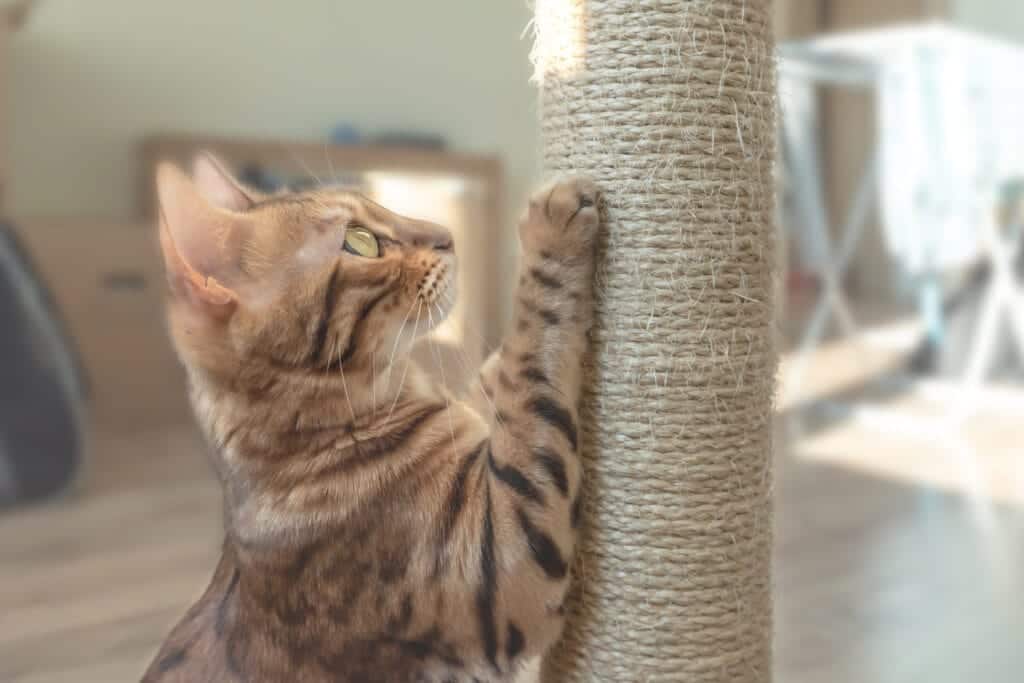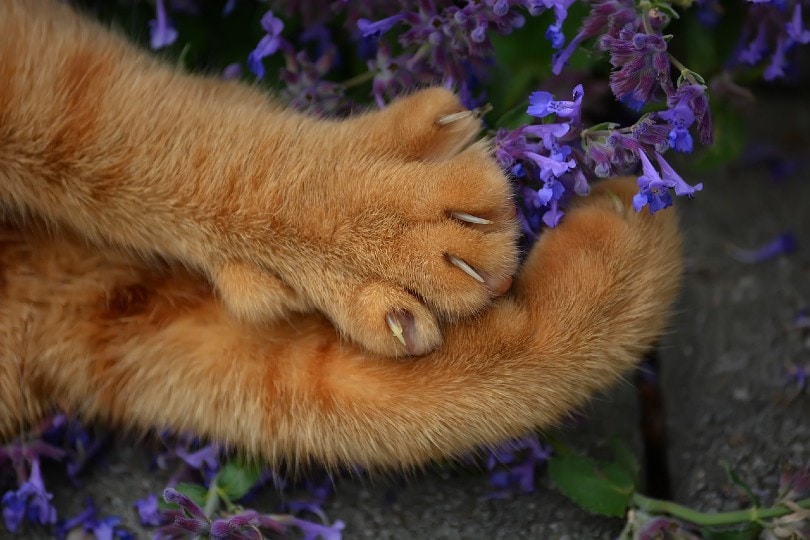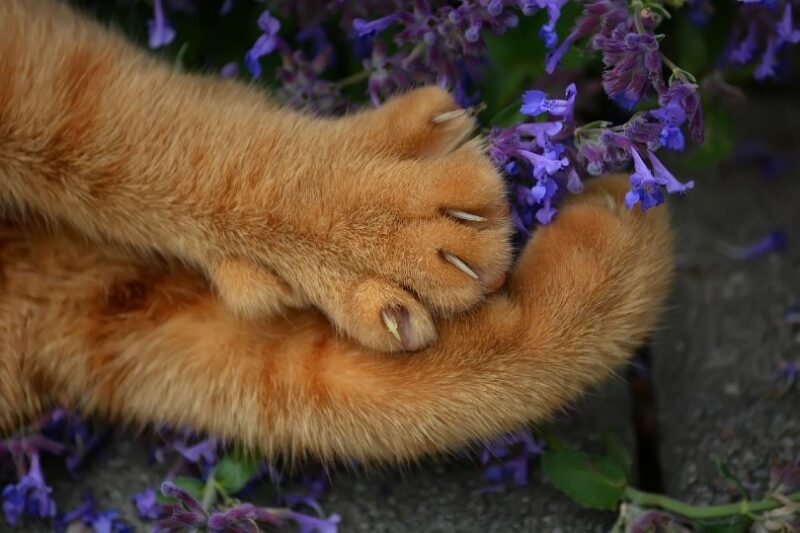If you’ve been around cats, it’s evident they’re closer to their wild roots than dogs. While humans welcomed canines into their lives up to 40,000 years ago1, it took us longer to warm up to felines, with domestication going back an estimated 12,000 years ago2. Thus, your cat may still have some ancient behaviors, like stretching their claws, that have a basis in survival functions.
Interestingly, humans and felines share about 90% of their DNA3. We may not have to look too far to find reasons for this behavior—some are simply common knowledge.

The 7 Reasons Why Cats Stretch Their Claws
1. Feeling Good
The chances are one of the first things you do after waking up is stretch. We do it because it feels good and pumps circulation to our limbs. Your cat isn’t much different. The difference is in how often they do it.
While we sleep an average of 8 hours a day, felines have us beat with about 16 hours. Cats also snooze in shorter stints with two peaks of rest—something scientists call polyphasic sleep patterns.
That means you’ll probably see your pet stretching out their claws more often because they wake up anew several times a day. This refers back to their evolutionary roots as a crepuscular predator. Dusk and dawn are ideal hunting times for felines because it is when their prey is most active. That’s why your cat tries to wake you up before your alarm has gone off in the morning.
2. Clipping Their Claws
It seems like no animal is as engrossed with their grooming as the domestic cat. You undoubtedly see your pet tending to their fur quite often during the day, particularly after they eat. You may also notice them biting at their stretched-out claws. It’s another remnant of wild behavior when a feline keeps their nails trimmed to help them hunt better.
A snag on something could interfere with pouncing on their prey or cause a painful injury if the claw catches on to something. Just chalk it up to your cat’s daily grooming routine as a lean hunting machine.

3. Marking Their Territory
When a feline stretches their claws, it’s almost inevitable that they’re going to scratch something next. As annoying as it is to us, it’s an innate behavior in cats. It’s risky for any animal to get into a physical fight with another. Neither can afford to get injured in a battle. Instead, they use other forms of communication to alert cohorts that a territory is occupied. Scent marking with the paws and scratching are forms of territory marking.
4. Claw Conditioning
We discussed claw trimming. Your cat may also stretch their nails to help remove their outer sheaths. Remember that felines are obligate carnivores that get the majority of their food from meat. They—and their claws—must be in tip-top shape to be successful hunters. Your cat will shed the outer sheath to allow new growth to take over the reins. It happens to each claw about every 3 months. Your pet may stretch their feet and tug on something such as the carpet to help loosen and remove them.
5. Getting Attention
Too often, people think of cats as being aloof. While they sometimes act that way, they are also loving animals that show affection, albeit on their terms. If your kitty stretches out their paw and claws toward you, they may be asking for attention from you. Felines use touch frequently among themselves to reinforce bonds. Your cat is likely doing the same thing with you.
6. Showing Love
Many cats will also show their love by kneading their pet owners. It starts with a gentle gesture with the feline outstretching their claws in the process. They often do it when they’re feeling content and usually only with close companions. However, when they knead, the claws often come out for whoever is getting their share of love.
Cats have scent glands in their pads. They’re also marking you as theirs when they’re stretching their claws and kneading you. Remember that felines are territorial. Also, they have a keen sense of smell, making it natural for them to act this way.

7. Feeling Playful
Sometimes, cats stretch their claws and body in preparation for play, not unlike a batter taking practice swings before coming up to the plate. It’s often accompanied by other behaviors and forms of communication, such as an upright tail or ears. These are signs that your kitty is getting ready to pounce on something. Again, it’s a wild behavior that mimics how they hunt.
Tips for Owners With Cats That Scratch
We understand that stretching claws and scratching may not be ideal in the house. However, we also agree with the stance of the American Veterinary Medical Association and The Cat Fanciers’ Association against declawing. Fortunately, there are several things you can do to redirect your pet’s behavior. A scratching post is an excellent way to discourage your cat from using your furniture.
We suggest sprinkling a little catnip on it to encourage your kitty to investigate their new toy. Instinct will kick in and take over the rest. You can also discourage your cat from scratching your furniture with some sticky tape on the arms. They won’t like the feel of it and hopefully, move on to something more desirable, like the scratching post you bought!
Some pet owners use nail caps on their cats. They are covers you put over the claw tips. Your kitty can scratch to their heart’s content without doing a number on your carpet or sofa. However, you must have a very cooperative pet to put them on with ease.
It is also possible for you to clip your cat’s claws at home or, alternatively, have your groomer or veterinary clinic do it for you.

Conclusion
One of the most rewarding aspects of having a cat in the home is being able to watch their instinctive behavior. Felines are still close to their wild side, which is evident in actions such as stretching their paws and claws. Things like marking their territory make this behavior a matter of survival, whether hunting their prey or warding off competitors. However, they also do it to show us they love us.
Featured Image Credit: Naturell, Pixabay












